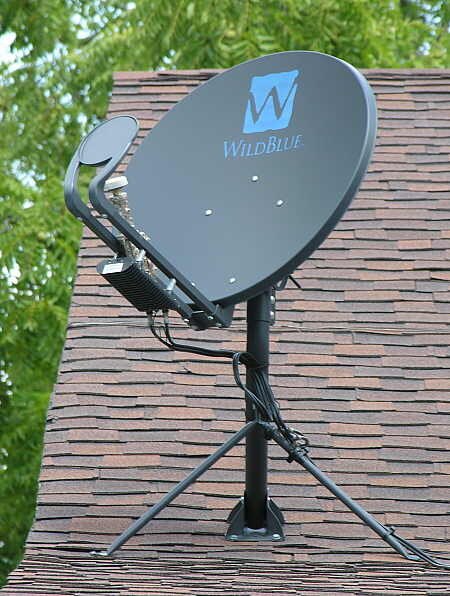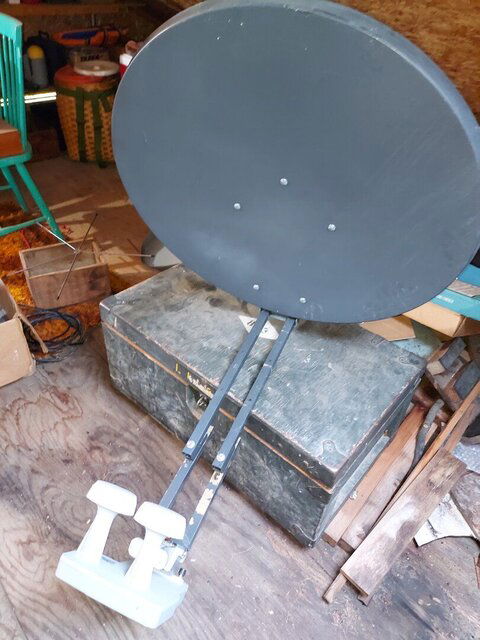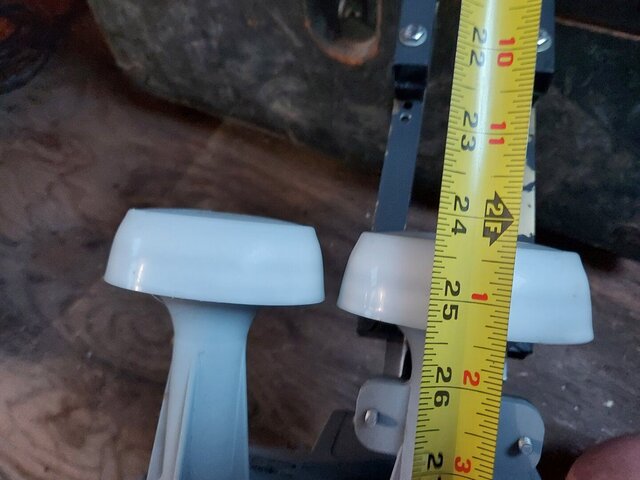So I have a DirecTV dish on top roof and I got tired of being up there on the hot roof while trying to get on to SES3. So I have an ole hughesnet eliptical on the ground and have been trying to wrap my brain around why I can not receive Horizontal TPs. I have a rock solid signal on the bird, TP 12180 (L of 90% and Q of 76+%)> I have tried two different LNBs. What am I missing?
SES-3 & Horizontal Issues
- Thread starter lawdog71
- Start date
- Latest activity Latest activity:
- Replies 20
- Views 5K
You are using an out of date browser. It may not display this or other websites correctly.
You should upgrade or use an alternative browser.
You should upgrade or use an alternative browser.
I get several horizontal transponder channels from SES-3 using my repurposed Orby dish. DW English, Cozi, NBC East Central, Mountain, and West feeds, in particular, come in well except for heavy rain situations. Also get the four NBC MUX channels on occasion, but those can be rather tempermental if the atmospheric conditions are somewhat less than ideal.
Aside from nailing the aim, is your skew correct for that satellite and your location, lawdog?
Richard
Aside from nailing the aim, is your skew correct for that satellite and your location, lawdog?
Richard
I am assuming-so, I was a Radioman in the Navy and always locked on to the strongest "beacon" to achieve lock on the "bird". So I setup dish to achieve the strongest Vertical signal (as shown in pics) then skewed LNB to try and lock in the Horizontal side but can't seem to get a lock no matter how far I skew.I get several horizontal transponder channels from SES-3 using my repurposed Orby dish. DW English, Cozi, NBC East Central, Mountain, and West feeds, in particular, come in well except for heavy rain situations. Also get the four NBC MUX channels on occasion, but those can be rather tempermental if the atmospheric conditions are somewhat less than ideal.
Aside from nailing the aim, is your skew correct for that satellite and your location, lawdog?
Richard
If you haven't done so already, you could check dishpointer.com to verify the skew value for that bird and your location. I would also suggest the possibility of the horizontal not working on your LNB, but I see that you've tried two different units.
Richard
Richard
Yeah, use dishpointer and my skew is further than DP states for the strongest Vertical signal, but I still can not lock-in on any H TPs no matter how much I adjust the skew.If you haven't done so already, you could check dishpointer.com to verify the skew value for that bird and your location. I would also suggest the possibility of the horizontal not working on your LNB, but I see that you've tried two different units.
Richard
I wonder if it's worth verifying that the receiver's putting out the proper voltage to select horizontal polarlity on the LNB.
Can you get horizontal TPs on another satellite?
Richard
Can you get horizontal TPs on another satellite?
Richard
I get the same result whether with the STB or Sat-Finder (Sat-Link) device.I wonder if it's worth verifying that the receiver's putting out the proper voltage to select horizontal polarlity on the LNB.
Can you get horizontal TPs on another satellite?
Richard
Your eliptical dish may be too small to receive the H transponders on 103W. The V transponders provide stronger signals.
Sent from my SM-G950W using Tapatalk
Sent from my SM-G950W using Tapatalk
I wonder about the size of his dish compared with my repurposed Orby. I get H as well as V polarity channels.
Richard
Richard
When you suspect that the LNB cannot switch to the internal horizontal antenna, rotate the skew 90 degrees further, and receive the horizontal signal with the "vertical" antenna.
Of course in the receiver, swap polarity H/V.
If LNB and LNB voltage is well, then you should again receive the vertical channels, as "horizontal".
If LNB and LNB voltage is defective, you would not receive the vertical channels anymore. (And maybe the horizontal channels would appear, as "vertical"; when indeed enough signal appears at the LNB?).
Greetz,
A33
Of course in the receiver, swap polarity H/V.
If LNB and LNB voltage is well, then you should again receive the vertical channels, as "horizontal".
If LNB and LNB voltage is defective, you would not receive the vertical channels anymore. (And maybe the horizontal channels would appear, as "vertical"; when indeed enough signal appears at the LNB?).
Greetz,
A33
For Utah, the skew of the LNB for 103W shown in the photo may be backwards judging by the way the cable is leaving the LNB.
Can you send a closeup photo showing the skew scale on the LNB?
Sent from my SM-G950W using Tapatalk
Can you send a closeup photo showing the skew scale on the LNB?
Sent from my SM-G950W using Tapatalk
I just set up a hughesnet dish. For my hughesnet dish the lnb has to be 24.5 in from center of dish and then point to middle of dish. I picked up 89 west first go around after fine tuning. 24.5 is focal point here's a link to a calculator Focal Length Calculation of a Satellite Dish - SatomsSo I have a DirecTV dish on top roof and I got tired of being up there on the hot roof while trying to get on to SES3. So I have an ole hughesnet eliptical on the ground and have been trying to wrap my brain around why I can not receive Horizontal TPs. I have a rock solid signal on the bird, TP 12180 (L of 90% and Q of 76+%)> I have tried two different LNBs. What am I missing?
Attachments
I just wonder. Why are you skewing the LNBF instead of the whole dish? The shape of the dish would tell me you are missing the center cross section of it. Stab a pole in the ground or mount the dish on its proper bracket on a chunk of plywood leveled and weighted down and give it a go that way. I have an old Wild Blue reflector that is repurposed that used a subreflector for the TRIA. The LNB mount was fashioned from square tubing and adjustable. I was able to get it peaked perfectly for a triple LNBF setup. Skew the dish, not the LNFB.
Hmm... interesting point, arlo. Lawdog's HughesNet dish is shaped like my Orby dish, which (with a linear polarization LNB) achieves its skew by rotating the entire dish -- not the LNB alone -- as you mentioned. (Of course, that sort of thing isn't an issue with similar-shaped dishes that receive circular polarization signals [DirecTV, for instance] and matching circular polarization LNBs, as there really isn't a skew adjustment with those.)
I think you might have hit the nail on the head. I think it's worth him setting the LNB skew to zero and rotating the whole dish to acheive his skew setting.
Richard
I think you might have hit the nail on the head. I think it's worth him setting the LNB skew to zero and rotating the whole dish to acheive his skew setting.
Richard
I picked this up and went to work. The first photo is how it was originally was. Don't really believe the fill-it-with-water and measure and calculate focal point. My signal was squat using those calcs. The closest way was to put aluminum foil on the outer edge and point it at the sun and focus on a piece of paper for the smallest spot. It ball parked me. The rest came after I located a sat. In and out with the LNBF. Lock it down. Skew angles, the same. rotate and peak. Especially when you're trying to get more than one sat. Yeah.Hmm... interesting point, arlo. Lawdog's HughesNet dish is shaped like my Orby dish, which (with a linear polarization LNB) achieves its skew by rotating the entire dish -- not the LNB alone -- as you mentioned. (Of course, that sort of thing isn't an issue with similar-shaped dishes that receive circular polarization signals [DirecTV, for instance] and matching circular polarization LNBs, as there really isn't a skew adjustment with those.)
I think you might have hit the nail on the head. I think it's worth him setting the LNB skew to zero and rotating the whole dish to acheive his skew setting.
Richard
This thing has been in my garage attic for years. But it worked really well.
Attachments
Don't really believe the fill-it-with-water and measure and calculate focal point. My signal was squat using those calcs.
Squat means bad? (Sorry, english is not my first language..)
There's often confusion which depth measure to use: at the center, or at deepest point? These need different equations, to calculate from.
On top of that, the satsig calculator and the parabola calculator 2.0 that can be found on the internet, have some incorrect outcomes! People often don't realize that. I guess that adds to people having doubts about parabolic calculations.
And where to find the calculated focal length of an offset dish? It's from the focal point to the vertex of the 'mother' prime focus dish. The location of the vertex is also not too difficult, to calculate.
However some people think the focal length would be measured somewhere towards the center of the offset dish; that is incorrect.
Assuming this wider-than-high dish is in fact parabolic in both the vertical and horizontal dimension, the 'water method' can indeed be used to calculate the offset angle. Or, alternatively, there is an equation to calculate it without the water method, from (just) four input measures. I wrote an article about that, about a year ago, with a derivation of the equation.
I've never used the 'mirrors' method, or the 'wet dish' method, to find the location of the focal point using the sun reflection. But I guess that would work too.
Greetz,
A33
Haha. "Squat" does indeed mean nothing, or lack of. Like let's go out for a beer or 3 and your buddy says "I ain't got squat". Obliging yourself to be the buyer.Squat means bad? (Sorry, english is not my first language..)
There's often confusion which depth measure to use: at the center, or at deepest point? These need different equations, to calculate from.
On top of that, the satsig calculator and the parabola calculator 2.0 that can be found on the internet, have some incorrect outcomes! People often don't realize that. I guess that adds to people having doubts about parabolic calculations.
And where to find the calculated focal length of an offset dish? It's from the focal point to the vertex of the 'mother' prime focus dish. The location of the vertex is also not too difficult, to calculate.
However some people think the focal length would be measured somewhere towards the center of the offset dish; that is incorrect.
Assuming this wider-than-high dish is in fact parabolic in both the vertical and horizontal dimension, the 'water method' can indeed be used to calculate the offset angle. Or, alternatively, there is an equation to calculate it without the water method, from (just) four input measures. I wrote an article about that, about a year ago, with a derivation of the equation.
I've never used the 'mirrors' method, or the 'wet dish' method, to find the location of the focal point using the sun reflection. But I guess that would work too.
Greetz,
A33
Anyways....
The calculators might work in a perfect world. Being an astronomy buff too, I've ground a few mirrors in my day.
You basically get the thing ground to a rough profile and use reflection of a light beam to determine the focal point. And grind some more. And more.
As for my C band dish when I brought it back to life I did use the calculations and equations. It got me "close".
But not a cigar (another term for attaining your goal). Ain't American English great!
As almost everyone does, you move the feed in and out. Turn it one way or the other. And peak for signal.
In the case of many LNB's you even might have to compromise H and V signals to get a happy medium due to probe angle differences.
Anyway again. In my venture getting the Ka band dish working for Ku. Focal length on paper was not focal length using the sun. The sun was the winner. And then tweaks....meaning "dialing in" or peaking for optimum
performance followed. But certainly not with a bucket of rocks.
On the orby dish the lnb is fixed you do turn the entire dish for skewI just wonder. Why are you skewing the LNBF instead of the whole dish? The shape of the dish would tell me you are missing the center cross section of it. Stab a pole in the ground or mount the dish on its proper bracket on a chunk of plywood leveled and weighted down and give it a go that way. I have an old Wild Blue reflector that is repurposed that used a subreflector for the TRIA. The LNB mount was fashioned from square tubing and adjustable. I was able to get it peaked perfectly for a triple LNBF setup. Skew the dish, not the LNFB.
Just wanted to say Thanks to ya'll. I'm a trucker and didn't have chance to work on the issue.
So I started from "scratch", taking all your suggestions in account. Got a new LNB, placed dish on one of my fence poles, extended the LNB arm with PVC pipe, skewed the dish (vice the LNB). Locked onto the bird on the Vertical side and made some small adjustments.
Using my satlink WS-6906, was able to get 87%+ signal but Quality was below 20% on the H TPs. So I connected to Sat RCVR and "boom" had lock on TP 11760. Made slight skew adjustment and then locked in on TP 11880.
Looks like my WS-6906 does not like Horizontals.
Thanks again ya'll.
So I started from "scratch", taking all your suggestions in account. Got a new LNB, placed dish on one of my fence poles, extended the LNB arm with PVC pipe, skewed the dish (vice the LNB). Locked onto the bird on the Vertical side and made some small adjustments.
Using my satlink WS-6906, was able to get 87%+ signal but Quality was below 20% on the H TPs. So I connected to Sat RCVR and "boom" had lock on TP 11760. Made slight skew adjustment and then locked in on TP 11880.
Looks like my WS-6906 does not like Horizontals.
Thanks again ya'll.
Attachments
Similar threads
- Replies
- 26
- Views
- 3K
- Replies
- 5
- Views
- 281
- Replies
- 6
- Views
- 800
- Replies
- 4
- Views
- 1K
- Replies
- 60
- Views
- 8K


![20210530_152402[1].jpg](https://cdn.satelliteguys.us/xen/data/attachments/132/132890-1d8e4ce1d97ee20641249089c8d776b3.jpg?hash=HY5M4dl-4g)
![20210530_152412[1].jpg](https://cdn.satelliteguys.us/xen/data/attachments/132/132891-c52632d64a19fc1bf720666f6ed55539.jpg?hash=xSYy1koZ_B)
![20210530_152519[1].jpg](https://cdn.satelliteguys.us/xen/data/attachments/132/132892-0e4438bb6211bc035339155844cf1674.jpg?hash=DkQ4u2IRvA)




![20210606_181419[1].jpg](https://cdn.satelliteguys.us/xen/data/attachments/132/132991-11dd94291dd7cd1f21b54fdfc2305852.jpg?hash=Ed2UKR3XzR)
![20210606_183655[1].jpg](https://cdn.satelliteguys.us/xen/data/attachments/132/132992-13e54e6e35521d1281cc9df4241d09aa.jpg?hash=E-VObjVSHR)
![20210606_183637[1].jpg](https://cdn.satelliteguys.us/xen/data/attachments/132/132993-8b7300d6dfd32bc447dbd659112ff855.jpg?hash=i3MA1t_TK8)